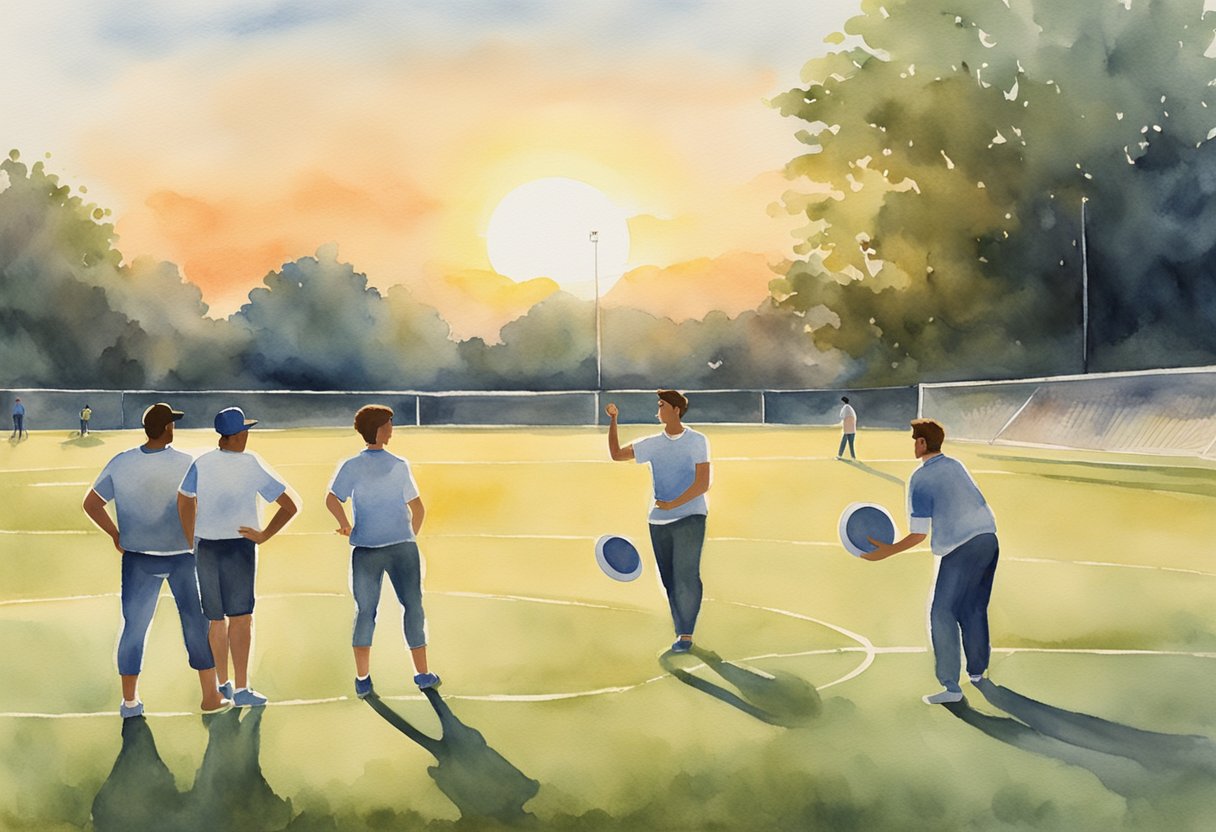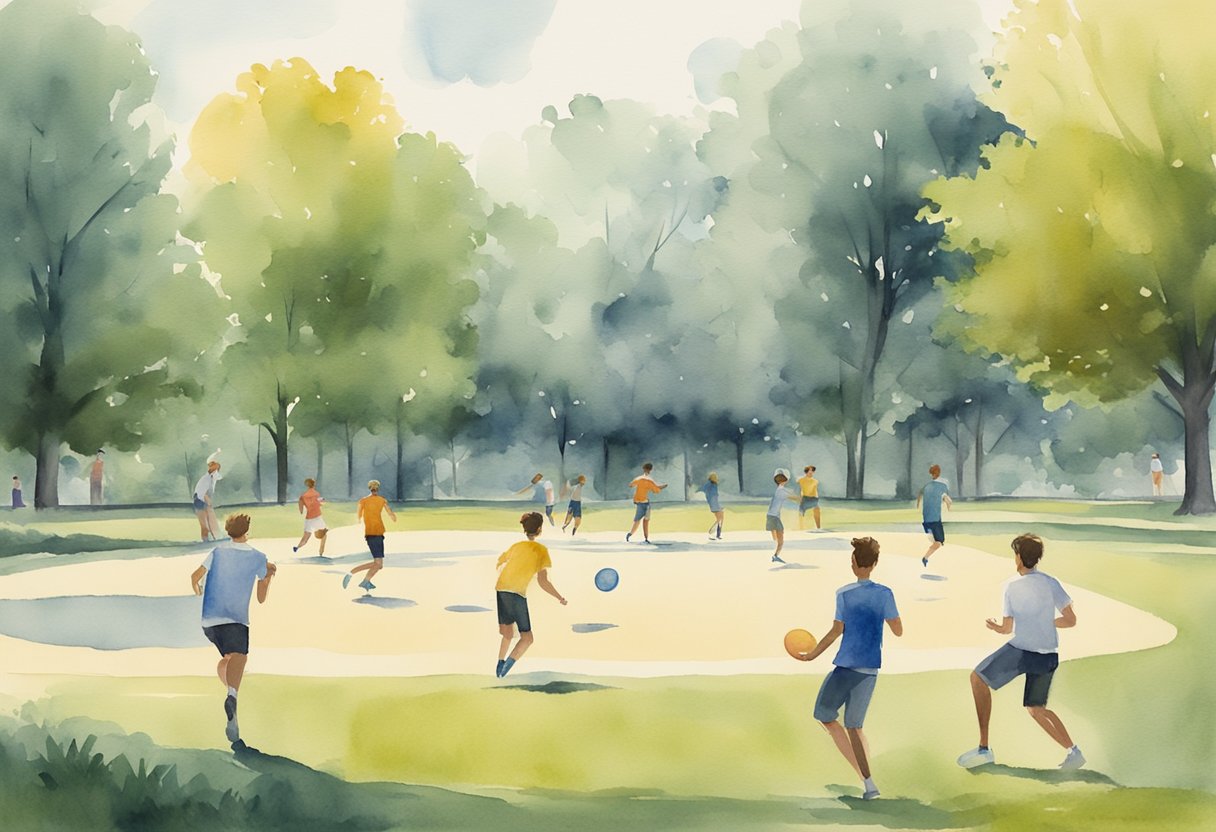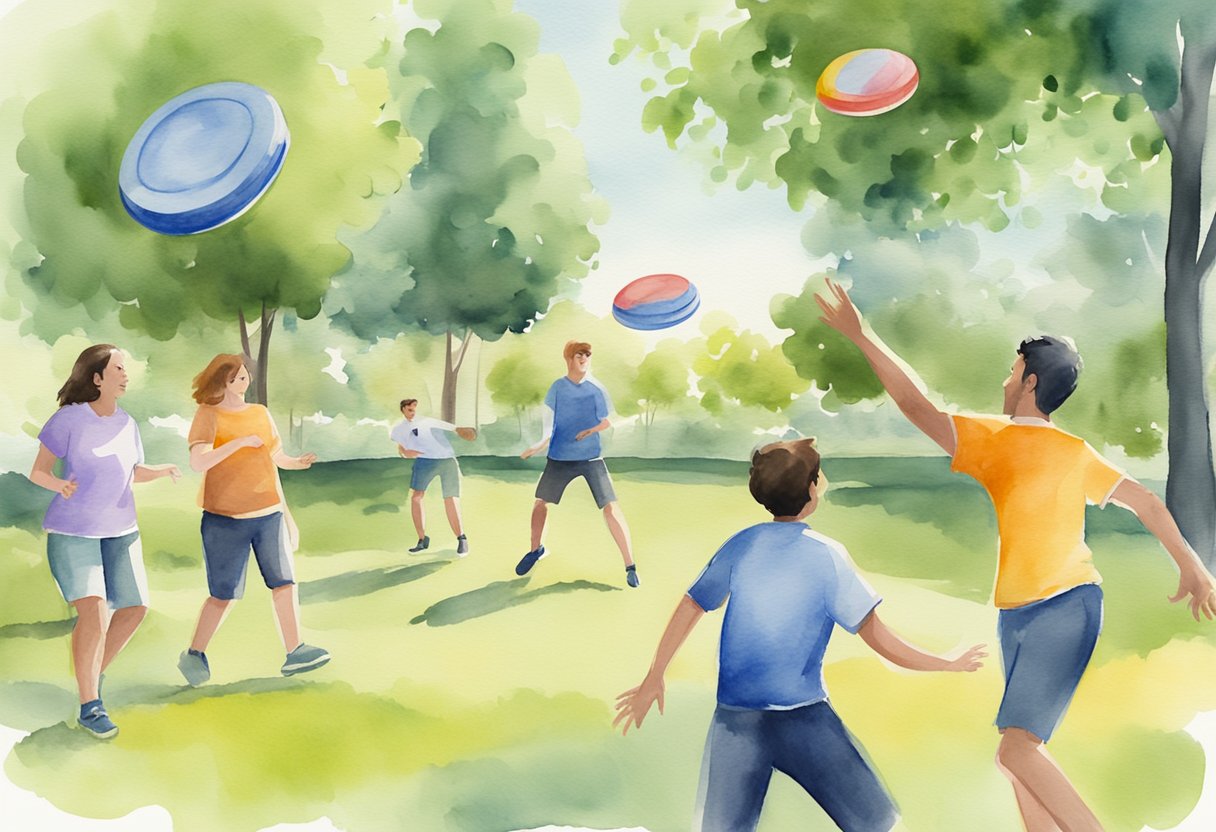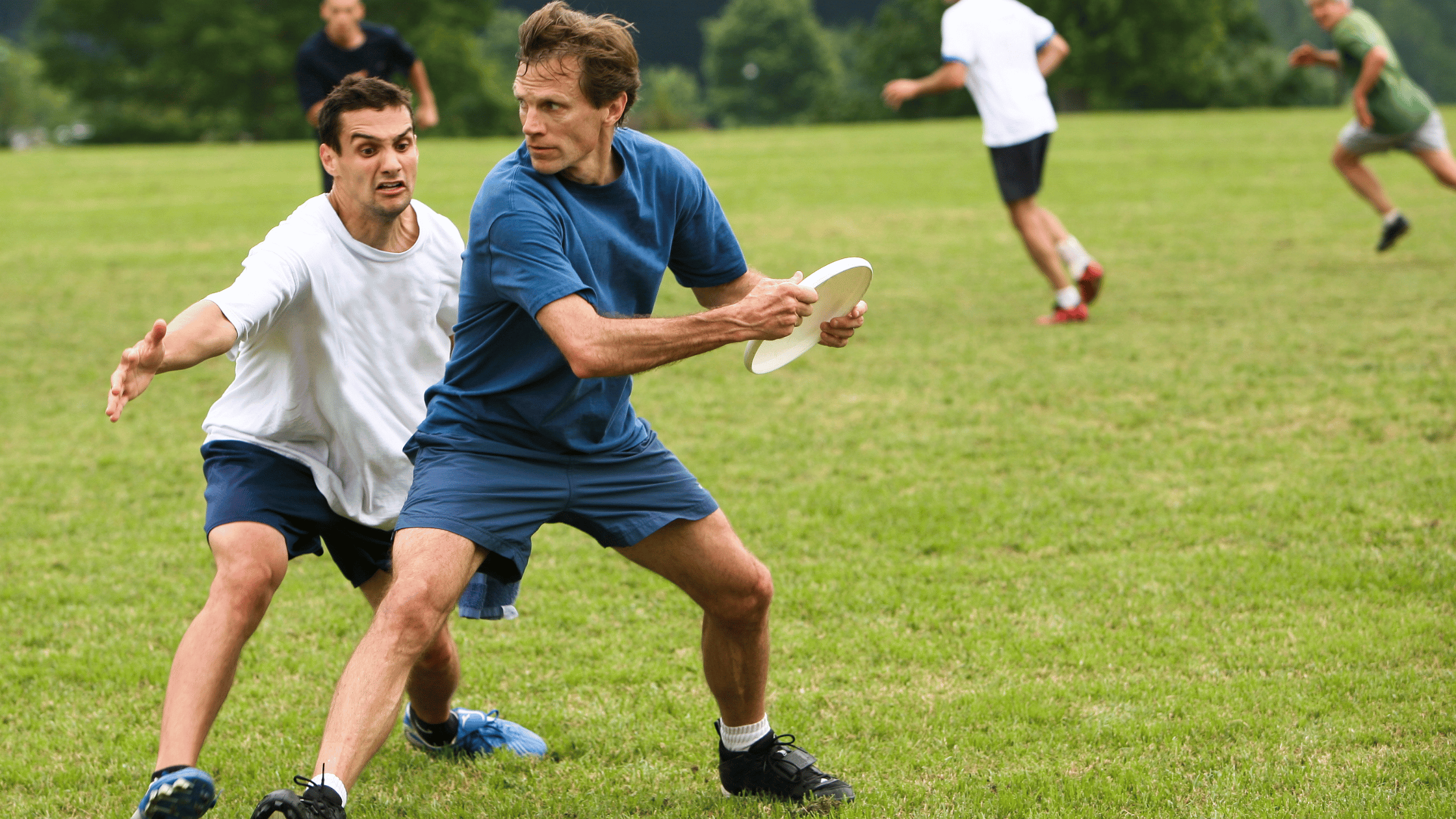Beginner’s Guide to Ultimate Frisbee: Starting Your New Hobby
If you’re looking for a fresh and engaging way to stay active, Ultimate Frisbee might just be the hobby you need. It’s a dynamic and inclusive sport that combines elements of soccer, basketball, and gridiron football, with the unique twist of using a flying disc.
You’ll get a full-body workout while enjoying the thrill and camaraderie of team play.

Getting started with Ultimate Frisbee requires minimal equipment, making it a highly accessible sport. All you need is a Frisbee, athletic attire, and a basic field setup.
For beginners, a standard disc size of 175 grams is typically recommended, and most players prefer the Discraft Ultrastar model.
As you embark on this exciting journey, you’ll quickly learn that Ultimate Frisbee is about much more than just throwing a disc around.
From mastering fundamental throwing techniques to understanding the essential rules and strategies, you’ll find plenty of opportunities to grow and improve.
With the support of a welcoming community, you’re sure to experience both physical and social benefits.
History of Ultimate Frisbee

Ultimate Frisbee has a unique and inspiring history that combines a rebellious spirit with innovative sports concepts.
Birth of the Sport
Ultimate Frisbee originated in the late 1960s, created by a group of New Jersey high school students who sought an alternative to traditional sports.
They combined elements from games like football, basketball, and soccer into a fast-paced activity centered on teamwork and strategy.
The influence of Jared Kass and others at Amherst College in 1966 further shaped the game, establishing rules similar to today’s play, such as scoring by completing a pass in the end zone.
The concept of the “Spirit of the Game,” emphasizing sportsmanship and respect, distinguished Ultimate from other sports, fostering a community focused on fair play and camaraderie.
Evolution and Growth
Through the 1980s and 1990s, Ultimate Frisbee experienced substantial growth, evolving from a casual activity to a structured competitive sport.
International tournaments like the World Ultimate Club Championships started in 1983, boosting global participation and interest.
The development of organizations like USA Ultimate formalized the sport’s rules and standards, enabling it to thrive in schools and communities around the world.
The focus on inclusivity and minimal required equipment made it accessible to diverse participants, further fueling its expansion.
Today, Ultimate Frisbee enjoys a dynamic presence globally, with numerous clubs, leagues, and tournaments celebrating its unique blend of athleticism and spirit.
Understanding the Basics

Ultimate Frisbee combines elements of soccer, football, and basketball, creating a dynamic and enjoyable sport.
You’ll need to grasp a few fundamental aspects to get started, including the game’s objective, the playing field layout, and the general rules.
Objective of the Game
The primary goal in Ultimate Frisbee is to score points by successfully catching the disc in the opponent’s end zone.
Each team comprises seven players, and the game is played without physical contact.
Every time you catch the disc in the opposing team’s end zone, your team earns one point.
Matches are typically played within a set time frame, and the team with the most points at the end wins the game.
Mastering effective communication and strategy alongside physical skills is crucial to excelling in this sport.
Field Layout
The field used in Ultimate Frisbee usually measures 70 yards by 40 yards with two end zones that are 20 yards deep each.
The boundaries are clearly marked using cones or lines, ensuring players can easily identify the playing area.
A standard field layout resembles that of a football field but is narrower.
Both teams start on their respective end zone lines at the beginning of each point.
Knowing the field’s dimensions and layout helps optimize play strategies and understand where to position yourself during the game.
General Rules
Ultimate Frisbee is a non-contact sport, emphasizing speed, agility, and skill over physical strength.
Players cannot run with the disc; once you catch it, you must establish a pivot foot while looking for a teammate to pass to.
If the disc hits the ground, goes out of bounds, or is intercepted, possession changes to the other team.
A typical disc weighs 175 grams, with many players preferring the Discraft Ultrastar model.
Familiarity with these rules is vital as they form the foundation of the game, helping ensure fair play and a positive experience for all participants.
Equipment and Gear

When getting started with Ultimate Frisbee, choosing the right disc, attire, and accessories can improve your gameplay and comfort.
Focus on selecting quality equipment that suits your needs and enhances your experience on the field.
Choosing a Frisbee
Selecting the right Frisbee is crucial. Look for a disc that meets the official standards, typically 175 grams in weight and 10.75 inches in diameter. This size is used universally in competitions and ensures optimal flight stability.
Brands like Discraft and Innova are well-regarded for their quality.
Testing a few different discs can help you find one that feels comfortable and flies well for your throwing style. Ensure the material is durable to withstand frequent play without warping or cracking.
Appropriate Attire
Wearing the right attire increases your comfort and reduces the risk of injury.
Choose lightweight and breathable athletic clothing that allows for a full range of motion. Moisture-wicking materials can help keep you dry during intense matches.
Opt for cleats suited to the type of field you’ll be playing on. Firm ground cleats work well on grass, while turf cleats are better for artificial surfaces.
Proper footwear will provide traction and support, crucial for quick cuts and sprints.
Additional Accessories
In addition to the basics, some accessories can further enhance your Ultimate Frisbee experience.
A quality pair of gloves offers improved grip, especially in wet conditions, and can protect your hands from blisters.
Consider a sports bag to organize and transport your gear.
This can include a water bottle to stay hydrated, sunscreen for outdoor play, and a basic first aid kit.
These items keep you prepared for different playing conditions and ensure a smoother game experience.
Skills Development

Developing skills in Ultimate Frisbee involves mastering throwing and catching techniques, as well as honing defensive skills. Each element enhances your gameplay and increases your understanding of this dynamic sport.
Throwing Techniques
Throwing is a crucial skill in Ultimate Frisbee. Learning different throws like the backhand, forehand, and hammer will elevate your gameplay.
- Backhand Throw: This is the most basic throw where you grip the disc and swing your arm across your body.
- Forehand Throw (Flick): This is achieved with a flick of the wrist, allowing for quick and precise throws.
- Hammer Throw: An overhead throw that can bypass defenders by throwing the disc at an angle.
Practicing these throws will ensure you have a versatile throwing arsenal.
Catching Techniques
Catching in Ultimate Frisbee is just as vital as throwing. Whether you’re playing offense or defense, secure catching techniques can make a big difference.
- Pancake Catch: Clap your hands together on either side of the disc to make a secure catch. This is especially useful when the disc is flying at chest height.
- Two-Handed Rim Catch: Use both hands to grip the outer rim of the disc. This technique is excellent for high-speed throws or when reaching above your head.
Regular practice with a partner using these methods will improve your catching reliability.
Defensive Skills
Strong defensive skills are crucial for preventing the opposing team from scoring. Positioning and anticipation are key components.
- Marking: Position yourself between your opponent and the disc. Staying low and agile helps block or intercept passes.
- Force: Direct your opponent into a less favorable angle using your body position. This limits their options and can lead to turnovers.
- Cutting Off Angles: Anticipate your opponent’s movement to cut off their path, forcing them to change direction. This disrupts their flow and can create opportunities for turnovers.
Gameplay Strategies

Mastering Ultimate Frisbee involves understanding both offensive and defensive strategies. By focusing on effective offensive plays and strong defensive tactics, you can significantly improve your performance and enjoyment of the game.
Offensive Plays
Executing effective offensive strategies is crucial in maintaining possession and creating scoring opportunities.
One common tactic is the vertical stack, where players position themselves in a straight line down the field, allowing for clear lanes and precise throws.
Another popular play is the horizontal stack, which spaces players evenly across the field. This setup allows for quick passes and opportunities for explosive cuts that can disrupt defensive setups.
You should also familiarize yourself with handler and cutter roles.
Handlers manage the disc and maintain possession, while cutters focus on creating separation from their defenders to receive passes.
Communication and timing between handlers and cutters are essential in executing successful plays.
By understanding these strategies, you’ll be better equipped to navigate and control the game’s pace.
Defensive Strategies
Strong defensive strategies can prevent the opposing team from scoring and force turnovers.
The force defense is a fundamental tactic, where you dictate the thrower’s direction, limiting their options to swing or pass the disc. This can disrupt the offensive flow and create interception opportunities.
Another approach is the zone defense, which focuses on cutting off passing lanes and controlling space on the field.
In a zone, players cover areas rather than marking individual opponents, making it easier to handle offensive plays like the horizontal stack.
Communication and awareness are key.
Stay alert to changes in the offensive setup and communicate actively with teammates to adjust your positioning and strategy.
Player Positions

Ultimate Frisbee requires players to adapt to various roles on the field. The primary positions are handlers and cutters, each bringing unique responsibilities that contribute to team success.
Handlers
Handlers are the backbone of your team’s offense. Their primary role is to control the disc and make accurate throws to advance the play.
You must master different throwing techniques, such as forehands, backhands, and hammers.
Handlers often stay closer to the disc, ensuring its movement across the field.
Strategically, you play a critical role in reading the game and making quick decisions to outmaneuver the defense.
A good handler anticipates movements of both teammates and opponents.
Communication is key, as you must coordinate with cutters and other teammates to execute successful passes and maintain possession.
Cutters
As a cutter, your task is to create separation from defenders to receive the disc. Agility, speed, and timing are crucial, as you often sprint long distances to open up space.
Cutters typically focus on changing direction quickly to shake off coverage.
Positioning is essential; you often initiate from the stack formation.
Your objective is to make strategic cuts that align with your handlers’ passes.
Coordination with handlers is vital for timing your runs effectively.
By mastering various fakes and pivots, you can consistently outplay opponents and become a valuable asset in moving the disc downfield.
Rules and Regulations

Understanding the rules and regulations of Ultimate Frisbee is essential to enjoying the game and playing it fairly. Key areas include fouls, infractions, and the importance of the “Spirit of the Game” philosophy that underpins every match.
Fouls and Infractions
In Ultimate Frisbee, fouls occur when a player’s actions physically impede an opponent’s movement.
These can include contact on the thrower, blocking without proper space, or tripping a player.
A foul can result in a turnover if contested or a replay if agreed upon.
Infractions are rule violations unrelated to physical contact, like traveling with the disc or making a double-team defensive play.
When called out, the play stops, and players set themselves according to the rules.
Consistent fouling or committing infractions can affect the pace and fairness of the game.
Familiarize yourself with these to maintain the integrity of the match and ensure a smooth play experience.
Spirit of the Game
The “Spirit of the Game” is a fundamental concept fostering mutual respect and sportsmanship among players.
It places the responsibility for fair play on players rather than officials, promoting self-officiation.
Players are expected to play without coaches or referees, requiring everyone to call their own fouls and resolve disputes amicably.
Encouraging honesty and integrity, this principle enhances trust and respect between opponents.
It emphasizes the joy of playing over winning, encouraging competitive yet courteous games.
Upholding the Spirit of the Game is crucial for maintaining the unique culture and camaraderie in Ultimate Frisbee, allowing everyone to enjoy the sport to its fullest.
Training and Conditioning

Embarking on a journey to improve your Ultimate Frisbee skills involves both physical fitness and technical training. Building strength, agility, and endurance is essential, along with honing fundamental skills through specific drills.
Fitness Training
To excel in Ultimate Frisbee, focus on building cardiovascular endurance and muscular strength.
Engage in exercises like running intervals, which mimic the quick bursts of speed needed during play.
Incorporating aerobic activities such as cycling or swimming can also enhance stamina.
Strength training is crucial for improving your throwing power and jump height.
Include exercises like squats and lunges to target your legs.
Integrate agility drills, such as cone drills or ladder drills, to enhance your on-field mobility.
Regular flexibility training through stretching routines helps prevent injuries.
Skill Drills
Developing your frisbee handling skills requires consistent practice of key moves.
Begin with simple throwing drills, gradually progressing to more advanced techniques.
Practice both backhand and forehand throws to increase versatility on the field.
For defensive skills, work on sprinting drills that improve your ability to mark opponents effectively.
Practice your catching techniques by receiving throws from different distances and angles.
Implement team drills to understand positioning and improve your spatial awareness during matches.
Utilizing tools like video tutorials from resources such as Flik can further refine your strategy and execution.
Joining the Community

Engaging with the Ultimate Frisbee community enriches your experience of the sport. You can find local teams, connect with players, and participate in tournaments to improve your skills and enjoy the social aspects of the game.
Finding Local Teams and Players
Finding local Ultimate Frisbee teams or clubs is essential for improving your game and enjoying the social benefits of the sport.
Start by searching online platforms dedicated to Ultimate Frisbee, where you can often find listings for local teams and leagues.
Reaching out through social media groups and forums is another great way to connect with players.
Many communities have dedicated Facebook groups where enthusiasts organize informal games and discuss local events.
Consider joining a pickup game, as it’s a low-pressure way to get involved and meet fellow players in your area.
Participating in Tournaments
Engaging in tournaments offers a competitive environment to test your skills and meet players from various backgrounds.
Many local and regional tournaments are open to beginners, providing a welcoming space to gain tournament experience.
To find tournaments, check websites that focus on Ultimate Frisbee and explore listings for upcoming events.
When participating, focus on understanding the tournament format and rules, which may differ slightly from casual play.
Being aware of these differences ensures you are prepared, and enhances your tournament experience.
Participating not only benefits your gameplay but also strengthens your connection with the Ultimate Frisbee community, fostering camaraderie and sportsmanship.
Safety and Injury Prevention

Engaging in Ultimate Frisbee requires understanding key safety measures. Start with effective warm-ups and cool-downs to prevent injuries. Knowing common injuries and first aid can help manage incidents efficiently.
Warm-Ups and Cool-Downs
Preparing your body before playing Ultimate Frisbee is essential to reduce the risk of injury.
Begin with a dynamic warm-up that includes exercises like jogging, high knees, and arm circles to increase blood flow and flexibility.
Prioritize stretching major muscles used in the sport, such as hamstrings, calves, and shoulders.
After playing, a cool-down session helps your body recover.
Incorporate static stretches to maintain flexibility. Focus on deep breathing to help your heart rate gradually return to normal.
Cooling down can prevent muscle stiffness and soreness, aiding in faster recovery.
Consistent routines for warming up and cooling down are crucial components of injury prevention in Ultimate Frisbee.
Common Injuries and First Aid
Ultimate Frisbee players often face a range of injuries, from muscle strains to more severe issues like orthopedic injuries.
Muscle strains commonly affect the legs and back due to the sport’s fast-paced nature. Implementing proper warm-up routines can mitigate this risk.
Bruises and sprains are also usual occurrences during gameplay.
Immediate application of first aid measures, such as the R.I.C.E method (Rest, Ice, Compression, Elevation), is vital.
In the event of severe injuries or discomfort, consult a healthcare professional promptly.
Awareness of these common injuries and their management ensures a safer playing experience.
Frequently Asked Questions

This section addresses common questions about key aspects of Ultimate Frisbee, from basic rules to necessary equipment and the principles of fair play.
What are the basic rules of Ultimate Frisbee that every beginner should know?
Ultimate Frisbee is played between two teams, and the objective is to score points by catching the frisbee in the opposing team’s end zone.
The game begins with a throw-off, known as a “pull,” and players cannot run while holding the frisbee. Instead, they must pass it to teammates.
How do you score in Ultimate Frisbee, and what are the point objectives for a game?
Scoring in Ultimate Frisbee involves catching the frisbee in the opponent’s end zone.
Games are typically played to 15 points, and to win, a team must have at least a two-point lead. In some cases, matches have a time cap to ensure they end in a reasonable timeframe.
Can you explain the standard layout and measurements of an Ultimate Frisbee field?
An Ultimate Frisbee field is a rectangular shape measuring 70 yards by 40 yards with two end zones, each 20 yards deep.
These measurements help regulate the playing area and ensure consistency in gameplay and strategies.
What essential skills are needed to play Ultimate Frisbee successfully?
Key skills for playing Ultimate Frisbee include throwing techniques, such as backhand and forehand throws, catching skills, quick footwork, and strategic agility.
Always maintaining awareness of your surroundings on the field is crucial for successful play.
What equipment do I need to start playing Ultimate Frisbee?
To start playing, you need a standard 175-gram disc, such as the popular white Discraft Ultrastar, and appropriate athletic shoes or cleats.
Comfortable athletic wear is recommended for optimal movement and performance.
What does ‘spirit of the game’ mean in the context of Ultimate Frisbee?
‘Spirit of the game’ refers to the emphasis on sportsmanship and fair play in Ultimate Frisbee.
Players are self-officiating, meaning they call their own fouls and resolve disputes on the field. This stresses respect and integrity among participants.

